what causes front of f150 to shimmy at 50 mph
Introduction:
There are many vehicle conditions that can crusade your vehicle to shake. In short, anything that rotates tin cause vibrations: Transmission, drive line, brakes, motor mounts (ok, the motor mounts don't rotate, but if they're worn, they tin can permit vibrations to be transmitted from the engine), and of course tires. Also, worn break parts tin let for vibrations. Granted, tires are the most common cause of vibrations and they're commonly the easiest to diagnose and cheapest to fix, but they are by no ways the only crusade of vibrations. In this article, we will give some simple guidelines to "pre-diagnose" any shakes you take and then you'll know where to turn for assist.
In this commodity we'll embrace:
- Shakes Not Caused By The Tires
- Shakes Caused By The Tires
- Balancing and Balancer Types
Shakes That Are Non Caused By The Tires:
Information technology shakes when you lot hitting the brakes, particularly under hard braking:
This is very common, and is near always caused by warped brake rotors (or drums, just unremarkably rotors). The rotors are the part of the disc restriction that rotates, and when yous apply the brakes, the calipers clasp the rotor to brand the vehicle boring downward. Over time, estrus causes the rotors to warp and you get a pulsation in the pedal and frequently in the steering cycle, especially nether hard braking. If this is the type of milkshake yous have, you should have the rotors checked for warping. If they are warped, they can be machined (turned) to be straight again, only you tin can simply turn them a couple of times before they get too thin, at which time they must be replaced.
The front end wobbles at a certain speed, but not every fourth dimension you drive that speed:
Some vehicles tin can choice up even violent wobbles (oscillation) at a certain speed, but not every time you drive at that speed. This is usually acquired by loose intermission parts or bearings. What happens here is that a loose suspension component tin can let the front end end to start wobbling, like when yous hit a bump, and once the wobbling starts, you lot accept to tiresome downwardly, or even stop to right it. Tires are very consistent, they will ever do the aforementioned thing at the aforementioned speed. So if the vehicle only wobbles some of the time, it is normally a loose or worn out suspension component that is to blame. In this instance, you should see your mechanic, or nosotros tin can look for the crusade if you lot want, but we don't do this blazon of repair.
The vehicle wobbles while accelerating hard, or climbing steep hills
This type of vibration is usually caused by motor mounts. If they get worn, vibrations can show upwards when accelerating hard, or pulling hills. Experienced mechanics tin diagnose this easily, and again, this is the realm of the mechanic.
In that location are actually many more types of "non-tire" related shakes, merely these are simply some of the about common. Transmissions and drive lines can cause shakes too, only they are non quite as uncomplicated to diagnose.
Shakes Caused Past The Tires:
As stated earlier, tires are very consistent, they will wobble at the same speed every fourth dimension, whether, yous're driving at a constant speed, braking, or accelerating. And then if you car shakes at the same speed (or speeds) every fourth dimension, tires are the commencement thing to bank check.
First Things Get-go: Bank check for Cupping and Flat Spots
Cupping:
The simple exam is to run your paw along the confront of the tire, and you can feel it. (You may desire to make certain you don't have steel cords showing on the tire offset, so you don't go cutting!) If the tire is flat, then adept, if it has small waves like on the ocean, you lot take cupping. Fifty-fifty though the tire in the picture is worn out, it clearly shows what we mean by cupping. If you look forth the edges of the tire, you can see that one tread block is raised up, and the adjacent one in the row is most completely smoothed out, so the adjacent raised again. If you can imagine what this would experience like if you ran your hand along it, then you should be able to imagine what this would feel like if it was mounted on your car!
Cupping tin can be caused by alignment problems, or inherent vehicle design issues. Rear tire misalignment on front end wheel drive cars is a textbook cause of cupping. In the center picture you can clearly meet the dished out spots on the left side of the tire, but if you look carefully yous can also come across a diagonal "valley" in the tire. Information technology goes from the outer apartment spot towards the middle of the tire and downward in the picture. Rear cycle misalignment will always show this diagonal blazon design. If this type of wear shows up on rear of your front end wheel drive car, the just way to right it is to take a four wheel alignment washed. You can put new tires on it, but unless you accept the rear of the vehicle aligned, it will merely be a thing of time earlier the new tires are cupped also.
On the other hand, all kinds of vehicles, particularly four bicycle drives, but even high end European cars, can accept inherent pattern problems that can cause cupping. On many of these vehicles, the only matter you tin do is keep the tires rotated, and if possible, choose tires with straight groove type treads. A direct (circumferential) tread tire volition cup less than more ambitious tread tires. The tire pictured higher up is a adept example of an aggressive tread tire used on a four wheel drive. The tire directly to the correct is actually off a trailer, but is a good instance of what we're talking nearly. Usually, having the car realigned and the tires balanced volition not solve this blazon of problem but should exist done anyway as a precautionary measure out.
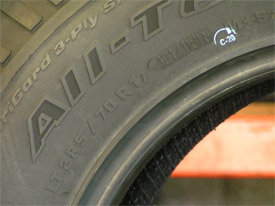
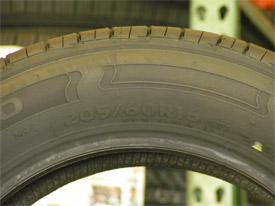
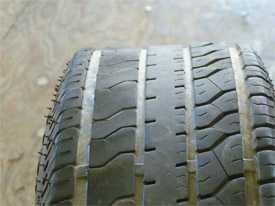
Flat Spots:
Flat spots are acquired by locking up the brakes. This is non unremarkably a problem if y'all take anti-lock brakes, but if you've had to stand on the brakes for any reason and had them lock up, you tin can take flat spots on your tires. If you lot've locked the brakes, and slid a long style, you volition definitely have apartment spots. Merely run yous paw along the tire again, or visibly inspect it, making certain to turn the tire, (so that you don't miss it if it'southward on the bottom). A flat spot is only what it sounds like, instead of the tire having a round contour, there will be one spot on the tire that has been shaved off, (or flattened). You can feel it with your paw, or if you spin the tire, in that location will exist an obvious dip when information technology gets to that spot. If information technology'due south non as well bad, you can sometimes rotate the tires, since the front tires will usually be worse than the back. If not, the flat spotted tires will have to be replaced.
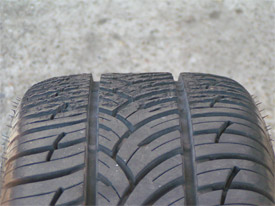
Over again, tires shakes are very consistent, they will always shake at the same speed(s). So if your tires have passed the commencement exam, you can often tell what kind of a problem yous have by the speed that the vehicle shakes (or wobbles) at.
Vehicle Wobbles At fifteen to 20 Miles Per Hour (mph)
If your vehicle wobbles at 15 to 20, become direct to a tire shop, practise not pass go, exercise not collect $200.00, definitely do non hit the pike with your family in the automobile, go directly to a tire store. Though this can exist acquired past a severely aptitude wheel, or severe cupping, the virtually likely cause is a separated tire. Separated tires are a very serious safety issue, and must exist dealt with immediately, since information technology's just a matter of time before the tire blows. A tire failure of this blazon almost always causes damage to the vehicle, only that's nothing compared to the many fatalities that are cause by this. Do not put this off!
To test for this, simply drive the vehicle for a short altitude at xv to twenty mph. If the bad tire is in the front end, the steering will rock back and forth, if information technology'due south in the rear, the rear of the machine will wobble in a similar manner. If you tin can find out which tire is separating, it may be all-time to put the spare on right then and there, so that y'all tin actually brand to the tire store. The tire with the trouble volition accept a bump along the tread face which is visible, or you tin can feel it with y'all mitt. If you utilise the hand test, the tire should accept a uniform profile except for the place where the separation is, which will be distorted, usually with part of the tread pushing away from the tire, ie.; a bump on the tread face. The pictures below illustrate this: The picture on the left is the "normal" side of the tire and is pretty uniform, while in the movie on the right, y'all can see the "bump" where the tire is separating. This separation is pretty big, but they will always start out smaller, so you should look for even small distortions in the tread confront.
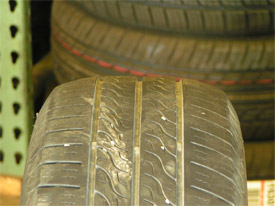
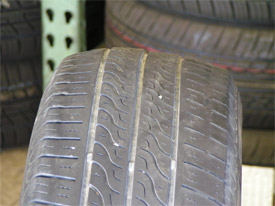
Vehicle wobbles at 30 to 50 mph:
The most mutual crusade of vehicle wobbles in this speed range is a bent wheel or mildly out of circular tire. Transmission and drive line issues can also show up in this range, but tires are the first thing to cheque. Unlike the low speed wobble, this is usually not a safety issue. You tin can usually see the wobble in the tire/wheel assembly if y'all put it on the balancer. In many cases, the tire can be better matched to bicycle (high spot to depression sport, or vice versa) and the wobble can exist eliminated. (This is where the "Road Force Balancer" comes in, and we'll explain that at the end of this commodity.) If that doesn't piece of work, the problem tire or wheel should be replaced. If the tires and wheels spin true and yous still have a trouble, and so you should accept a mechanic await at the vehicle.
Vehicle Shakes at l mph or college
The nigh mutual cause of vehicle shakes at 50 mph or college is tire residuum. Again, manual or drive lines tin cause this, but the tires should be the start thing to have checked. A tire or wheel that is slightly aptitude or out of round can likewise exist a cistron hither, and this can be checked while the tire is on the balancer. Patently, the first affair to check is the tire balance, and only afterward the tires accept a make clean bill of health should you take it to a mechanic.
Balancers: Static, Dynamic and Route Force
Over the years there have been various methods of balancing tires. Without going into the history, we will merely explain the types in common use today, and when yous would use one method or another.
Static Balancing
If you think of how your tires are mounted on the car, static balancing refers to balancing the tires only from up to down, or across the tire. In almost cases, this works pretty well. Though not used very much these days, bubble balancers and "on the car" balancers tin only do this type of balance. Likewise, if you don't want weights on the outside of your wheels, you volition often become this blazon of balance. This is too called "single airplane" balancing.
Dynamic Balancing
Dynamic balancing volition not just residual the tire from up to downwardly, just also from side to side, and is oft called "dual aeroplane" balancing. It is normal for tire/wheel assemblies to be out of residual in both of these ways, and this makes a dynamic balancing a much amend choice than a static balancing. This can just exist washed past modernistic "figurer" balancers, and requires weights to be put on both sides of the wheel. However, if you desire a good balance, and either your wheels won't have weights on the outside, or y'all just don't want the come across them, you can often still have a two aeroplane balance. Many modern vehicles are designed with "positive outset" wheels, which ways that the bolt face is pushed towards the outside, then almost of the wheel is inboard, towards the vehicle. In this type of cycle, information technology is easy to put the outer weights just behind the face up of the wheel and the inner weights on the inside edge. This allows for a proper dual plane balance and is the preferred method (autonomously from weights on the outside border). Nevertheless, if you accept a standard beginning (bolt confront in middle of the wheel) or a reverse offset wheel (bolt face toward the within edge of the wheel), then you really can't get a skilful dual airplane balance without putting weights on both sides of the wheel.
Road Force Balancing
Road strength balancing is a relatively new technology. The idea is that a "strength wheel" is mounted on the balancer, (this is the black roller wheel on the right side of the balancer in front of the hood) and equally the tire turns, the wheel pushes confronting the tire and measures variations in pressure around it'south circumference. Since this simulates how the tire volition interact with the road, it is called "road force balancing". These balancers have prescribed "tolerances" that let unlike levels of "route strength variation" for unlike types of vehicles.
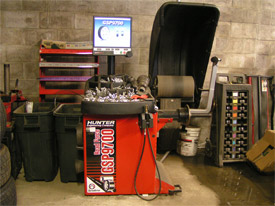
Finding out the "road strength variation" of a tire is all well and good, just if a tire/bicycle assembly has as well much variation, then what would y'all do? This is where these balancers smoothen: Having recorded the road strength variation effectually the tire, the balancer then directs the technician to take a reading of the cycle. The software in the balancer and so calculates whether the tire or the wheel is the problem, and whether or not the 2 tin can be "force matched" to meet the tolerances. If they can be matched, the balancer specifies a spot on the wheel, and a spot on the tire, where if the two spots are matched together, (by turning the tire on the wheel) the tire/bike associates will then have the lowest possible road forcefulness variation. Granted, the automobile doesn't always go it right the first fourth dimension, and there are some tricks an experienced tire technician can apply to expedite the procedure, but much of the time, trouble tire/wheel can exist fabricated to rest without having to exist replaced. This is of import considering no tire manufacturer volition replace a tire for beingness "out of round" unless it is virtually brand new. (This is fair because tires can get out of round over time for various reasons other than poor workmanship.) Then if your tires are even a little worn, this is ofttimes the only affair you lot tin even do (brusque or replacement, which you would accept to pay for). Without a road force balancer, a tire can be matched for roundness (not forcefulness variation) by trial and error, but that can mean turning each tire on it's wheel up to eight times(!) and visually checking it on the balancer every fourth dimension. Not only does this type of balancer greatly expedite the procedure, simply the specific tolerances create an objective standard.
Obviously, we at Souza'southward use this blazon of balancer. Withal, since this process is time consuming, and in the majority of cases not necessary, we don't road force every tire. We'd then have to raise our prices to pay for all the extra labor. However, if you have a problem that standard balancing won't gear up, we will go to this next level and do everything we can to fix your problem.
Back To Tires 101
corbouldowelp1975.blogspot.com
Source: https://www.souzastireservice.com/Tires-101/Shakes-and-Wobbles
0 Response to "what causes front of f150 to shimmy at 50 mph"
Post a Comment